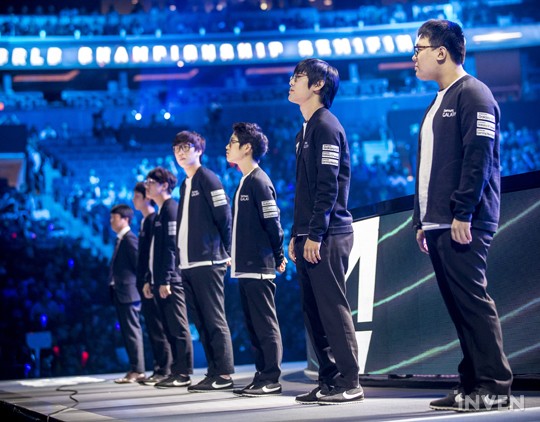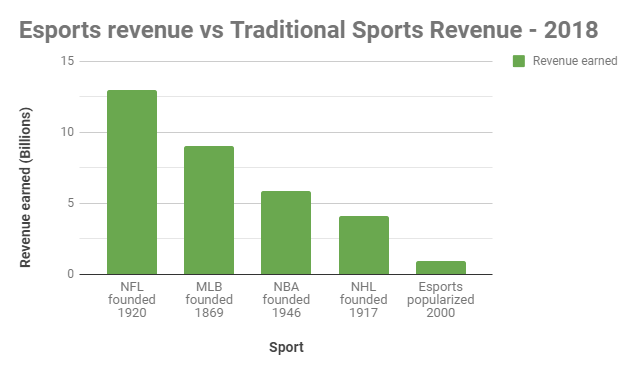
In this modern day and age, youth are pursuing new interests and hobbies that some would consider “less than conventional.” The internet is a powerful medium that facilitates many of these hobbies: graphic arts, programming, video games, and esports. Esports has been a rapidly growing industry in the past few years in terms of viewership, financial investments, and public interest.
As the highest echelon of competitive gaming grows in size, so does its viewership. This has caused an increase in awareness for many youths; some kids even reaching their teenage years watching esports tournaments. Unfortunately, for those who are not already well-versed in the world of esports it can be a confusing experience trying to learn the ins and outs.
What is esports?
Esports is the overall colloquial term used to describe competitive gaming. This includes any entity involved in the playing, hosting, coaching, or watching tournaments and leagues centered around video games. When most people first hear of esports it’s understandable that their first reaction is skepticism, because really, how competitive can Pacman or Candy Crush get? What people fail to realize is that the games played competitively have a level of complexity that basic games like Candy Crush lack. Thousands of hours are needed to gain an intimate understanding of the mechanics and strategy needed to win and have a layer of depth that is impossible to spot from a layman's eye.
Esports, much like conventional sports, is not just one game, but is comprised of a multitude of games, some larger than others. Some of the biggest esports titles include: League of Legends (LOL), Dota 2, Counter Strike: Global Offensive (CS:GO), Overwatch, Heroes of the Storm, Starcraft 2, Hearthstone, and Fortnite. PC gaming represents the most popular way to compete, as the accessibility, versatility, and sheer power of a computer have traditionally outpaced consoles, which lend itself to a more casual crowd. The aforementioned games are the top played esports titles currently and are all played on PC.
However esports that are not played on PC can still thrive. Titles like Halo 5 Guardians (Xbox One), Call of Duty: WW2 (PS4), and various fighting games such as Tekken, Street Fighter, and Super Smash Bros. each manager to attract an audience despite their console roots.

Due to the nature of video games, not all tournament and league games have to be played in person. As long as teams are within the same region, to a reasonable degree, (Americas, Europe, etc.) games can be played online. In-person tournaments, however, are the preferred method, as not only is it exciting for both the fans and players to be together in the same environment and socialize, but live play offers the smoothest, and most even playing field.
These in-person tournaments/games are called “LANS”. These LANS are not entirely different from traditional sports games, but the atmosphere can differ. Oftentimes, tournaments are hosted in the same venue as gaming conventions, so players and attendees have time to socialize, buy merchandise, and absorb the experience. Due to games being played mostly online, it is easy to forget that esports and gaming, in general, is first and foremost a community event. These gaming LANS help rekindle that sense of community, as sitting in a large stadium filled with thousands of fans cheering for the same game as you, are truly an electrifying experience.

Each game has its own unique tournament and league system, all varying on popularity, developer support, and genre. Games such as CS:GO have professional third-party organizations that host online leagues and tournaments. Weeks of playing often culminate into a final in-person LAN for the grand finals. These third-party organizations are nothing to be scoffed at either, for companies such as ESL have deep-rooted connections in the western esports scene, dating back to its inception.
In addition to these smaller third party hosted tournaments, the developers of a game will several times a year donate a large sum of money to the prize pool of these tournaments and create what are aptly called “Majors”. In the case of CS:GO, these Majors occur twice a year, and have prize pools of a million dollars. Simply participating in one of these Majors, let alone winning, is a feat all esports players strive to meet. Other games such as League of Legends and Overwatch have developers that are more hands-on with their esports scene. Riot and Blizzard respectively have their own franchised league in the form on the League Championship Series (LCS) and Overwatch League (OWL). Each league is fully funded and run by developers who are leaders in the esports industry.
Having a franchised league simply means organizations have the right to operate and play in a specific location and league. This means no matter how poorly the team plays, that organization has the right to maintain a spot in said league. In traditional esports, there are many qualifying stages that teams need to win to earn a spot. Franchised leagues are the model for what most, if not all, major traditional sports operate. The buy-ins needed to simply gain a spot in these leagues are massive, let-alone the cost of running a team. The sheer fact that massive organizations are scrambling to get their hands in the esports pool, when the barrier of entry is so high, is a testament to the level of legitimacy and professionalism achieved by the burgeoning esports industry.
The owner of the New England Patriots, Robert Kraft, purchased a franchise in the Overwatch League for a staggering $20 million dollars. Similarly, the co-owner of the Golden State Warriors, Joe Lacob, paid $13 million dollars for his team to participate in the LCS. A plethora of other popular sports team owners have followed suit and brought their own spots in franchised leagues, or otherwise invested in professional esports teams.

The Teams
An aspect of esports and traditional sports that overlap is the system by which free agents and players join teams in franchised and non-franchised leagues. This is speaking from a non-legal sense, as contractually esports and traditional sports may wildly differ, the general actions, however, remain similar. Upcoming players are constantly trying to prove their talent and get scouted by larger teams. They often throw themselves into lower scale tournaments with smaller teams, in an attempt to have their efforts spotted by larger gaming organizations. This constant desire to be picked up is not in vain, however, as being placed on a higher tier team can reap many benefits, similar to traditional sports.
These benefits vary from team to team, but a list of possibilities include: paid salary, support staff (coaches, analysts, etc.), housing (gaming house residence to improve synergy and scheduling), paid flights, housing, and food when travelling, name-awareness, a chance to practice with better players, and most importantly, a shot at playing in bigger leagues with more prestige and prize money. According to CS:GO pro “es3tag” (translated into English) “G2 is a world-renowned team, they are stars … They have taken the best stars from the two best French teams, and then they have given them a salary of 180,000 kroner.” This translates to $22,000 USD, as a baseline salary. The players total income is also supplemented from other sources of income, such as winning tournaments, and advertising from streaming. Of course, these figures only apply to the very best of the best, so if players aren’t at the top they’ll be earning a fraction of that sum.
With both player salary and tournament prize pools constantly on the rise, the question is begged: where is all this money coming from? The monetization model for esports teams and players currently is neither elegant nor the most optimized. Nonetheless, the amount of money coming into the sport is steadily growing and is proving sufficient. The main sources of income for big-name organizations are: sponsorships, advertisements, merchandise, media rights, ticket sales, and game publisher fees. If you look at any major gaming organization website, it will not be very hard to find their list of sponsors/advertisers. These can range from gaming accessory companies to tech companies like Intel to energy drinks such as Red Bull.
In the case of the renowned North American company, “Cloud 9”, they are backed by the U.S Air Force! Media rights is the colloquial term used to describe any revenue stemming from various broadcasters who pay for the right to stream certain games. Game publisher fees are similar, where the publisher/developer pays to host tournaments.
Generating Income for players.
On the player end of the spectrum, there are four main ways of generating income. These are salary, content creation, prize money, and sponsorship/advertisement deals. Salary and content are not mutually exclusive; however, they usually are. This is due to a phenomenon that plagues many pro players: practice all day with teammates in preparation for tournament or prepare less and create content such as streams or videos. Esports in this day and age is so competitive it is common practice for players to spend upwards of 10-12 hours a day practicing with a team, and rarely do players have the patience or drive to stream or create content for another few hours.
Devoting time to content creation is a far more stable and consistent form of revenue generation compared to relying on winning every tournament. Unless you are in the top 15 teams in the world, content creation will vastly overshoot any salary given, so it is truly a risk being a competitor only; a risk only taken by youths (approx.16-22), or those with money saved.

Growth in any entertainment industry can be measured via many metrics, one tried and true metric, however, is viewership. This concept applies to esports as well, as viewership has been blooming in the last few years. Viewers are coming in from all corners of the globe, albeit on different forms of media. In the western world, the primary broadcasting outlet has been a website called Twitch.tv.
Twitch has been ingrained in the gaming community for several years now, as it is the primary place for streaming live games. There are entire careers and industries built off live streaming platforms, where hundreds of thousands flock to watch their favorite pro player or online entertainer play games. Tournament organizers take advantage of Twitch and live stream the matches for free. Due to the success of Twitch, many other sites have tried to jump on the game-streaming business. Websites such as YouTube and Facebook have joined the fray, albeit to varying degrees of success, and nowhere close to Twitch’s level. YouTube has seen the most success of the two contenders, as it is an already established site in the gaming world. In short, if you are hoping to catch the next big tournament from your computer, head over to Twitch.tv or YouTube live streams. If you want to enjoy an esports game from the comfort of your couch, you’re in luck, as ESPN and other mainstream TV networks have begun setting time blocks for esports. It is safe to say that esports is on a meteoric rise in the western world.

It is important to understand that despite all the recent hype garnered by huge bursts of momentum, esports is still very much in its infancy stage. In all metrics, traditional western sports dwarf the numbers esports puts up. If the industry wants to catch up to the big players, we’ve got a lot of work cut out in the coming years and decades. The one constant, however, is the love and dedication of the esports community toward their games, and the competitive drive that pushes them to improve.
Shifting perspectives
This is proven when players like Alexis S., who plays a smaller game called Team Fortress 2, plays not for the cash pool, but to “get recognition from teammates and players. “Players are not alone in this endeavor, as the greater online community can provide helpful guides, and be a place to find new friends and teammates. High School Esports League (HSEL) is one such organization that grants high school players an opportunity to compete and meet similar like-minded young people from across the country. Despite their young age, many of these students are well versed in the worlds of esports and the games they play. Players such as “Dash” or Eugene T. believe in a future where competitive esports is: “Just like any regular sport”, and as public awareness grows, the image will shift away from being “just a bunch of nerds clicking buttons” to an industry that should be taken seriously.
Even members of the older generation are starting to shift gears, as father of HSEL player Jacob S. comments “I think Esports are exciting and I can't wait to see how the industry develops over the next several years. I'm excited that my son participates and think it would be pretty cool for him to explore the development side as well.” Another parent of an HSEL player has similar thoughts, stating: “The industry has taken off. The televised events are exciting to watch. I can see why gamers are drawn to it. You know esports is here to stay since colleges are offering scholarships to players. esports requires teamwork, discipline, trust and all the other things that other sports do. It even offers a professional option that pays pretty well. I guess as parents we can't say put that game down anymore.”
With the top end of the pro scene expanding, more avenues are being created to ascend the ranks. Just recently Blizzard unveiled their Path to Pro program for Overwatch, that allowed up-and-coming players to prove themselves. A more traditional familiar method is the path that starts with high school, then into college, and finally into pro. The college esports scene is gaining traction as well, companies like Tespa and Collegiate Star League (CSL) are college-level esports leagues which offer thousands of dollars’ worth of prizes. College esports clubs are now seeking to recruit the best players, using scholarship money as an incentive.

The best way for skilled high schoolers to gain the attention of potential college recruiters is to join HSEL. HSEL is the best solution for high schoolers to delve into world of esports as not only do they give players a chance to prove themselves for money and fame, but also gives them a direct pipeline to a handful of the top college recruiters. The future of competitive gaming is uncertain. In 50 years, this whole trend could just be a memory of the early 21st century. But for at least the foreseeable future, gamers around the world can rejoice as we enter the renaissance of esports.
Sources:
https://dotesports.com/business/news/franchising-esports-owl-lcs-2018-19805
https://www.statista.com/statistics/490480/global-esports-audience-size-viewer-type/
https://www.businessinsider.com/the-esports-audience-is-escalating-quickly-2017-3
Questions
https://www.businessinsider.com/live-streaming-esports-online-tv-2018-1
http://www.csgovideos.net/2017/09/19/biggest-salary-in-csgo-g2-players-are-earning-29000-per-month/
https://www.dexerto.com/news/richard-lewis-breaks-csgo-player-salaries/24790
https://www.esportsearnings.com/tournaments
https://www.cbinsights.com/research/esports-vs-traditional-sports-expert-research/
Sort by:
Comments :0






